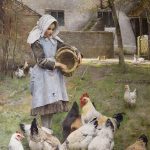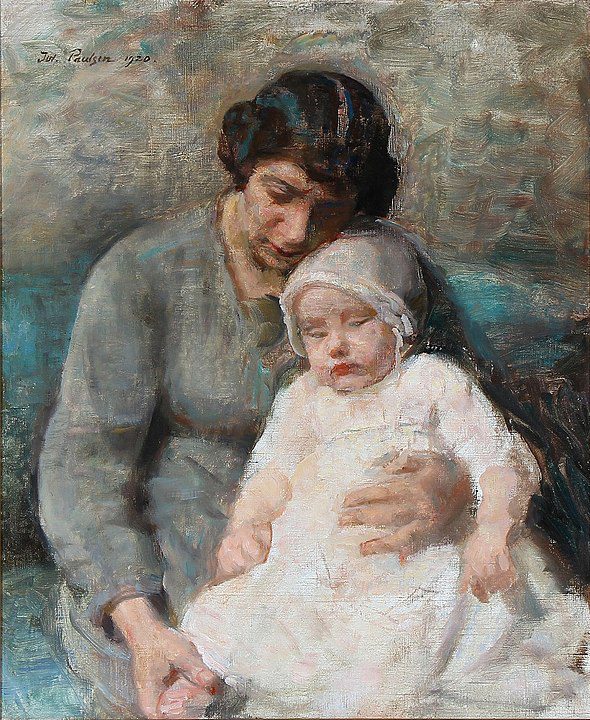
Amongst the many great Danish artists, Julius Paulsen holds a significant place. Born on October 22, 1860, in Odense, Denmark, Paulsen’s life and work bridged the 19th and 20th centuries, reflecting the cultural and artistic transformations of his time. His contributions to art are characterized by a meticulous exploration of light, shadow, and human emotion, making him a pivotal figure in Danish and European art history.
Julius Paulsen was born into a family that appreciated art, though not one of artists. His early interest in drawing and painting was evident, and he pursued this passion with vigor. In 1879, Paulsen moved to Copenhagen to study at the Royal Danish Academy of Fine Arts, a decision that would shape his artistic trajectory. Under the tutelage of notable artists such as Laurits Tuxen and P.S. Krøyer, Paulsen honed his skills, particularly in the use of light and color.
Influences and Early Career
Paulsen’s early work was influenced by the Danish Golden Age painters and the Skagen Painters, a group of artists who worked in the late 19th century and were known for their depictions of the Danish landscape and people. The influence of these artists is evident in Paulsen’s meticulous attention to detail and his ability to capture the subtleties of light.
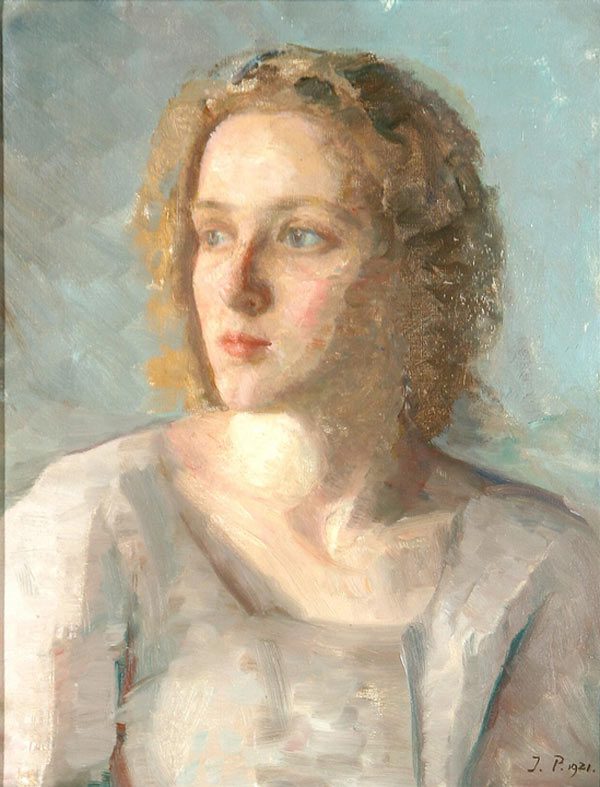
In 1882, Paulsen made his debut at the Charlottenborg Spring Exhibition, the premier venue for contemporary art in Denmark. His early works were well received, showcasing his potential and skill. A pivotal moment in his career came with his painting “A Young Girl at the Piano” (1887), which earned him critical acclaim and established him as a promising young artist.
Paris and the Symbolist Movement
In the late 1880s, Paulsen traveled to Paris, the epicenter of the art world at the time. The city was alive with new artistic movements, and Paulsen was particularly drawn to Symbolism, which emphasized the representation of ideas and emotions over realistic depiction. Influenced by artists such as Puvis de Chavannes and the early works of the Nabis group, Paulsen’s style began to incorporate more abstract and symbolic elements.
During his time in Paris, Paulsen exhibited at the Salon, where his works were noted for their elegance and emotional depth. Paintings like “The Garden of Gethsemane” (1893) exemplify his Symbolist phase, with their moody atmospheres and contemplative figures. These works marked a departure from his earlier, more naturalistic style, reflecting a growing interest in the inner life and the spiritual aspects of human experience.
Mature Style and Major Works
Upon returning to Denmark, Paulsen continued to evolve as an artist. His mature style is characterized by a harmonious blend of naturalism and symbolism, with a focus on portraiture and genre scenes. One of his most famous works from this period is “A Jewish Wedding” (1905), a large-scale painting that captures the solemnity and joy of the occasion with exquisite detail and sensitivity.
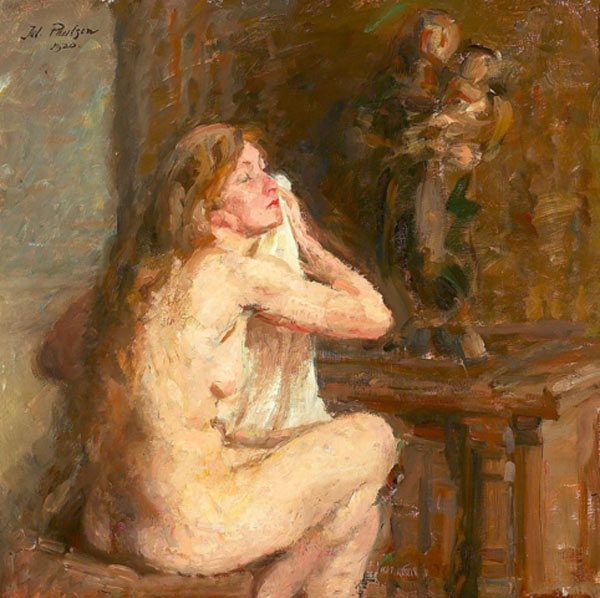
Paulsen was also a master portraitist. His portraits are notable for their psychological depth and the way they capture the essence of the sitter. Among his most celebrated portraits are those of his contemporaries, such as the writer Herman Bang (1901) and the composer Carl Nielsen (1912). In these works, Paulsen’s use of light and shadow creates a sense of intimacy and immediacy, drawing the viewer into the personal world of the subject.
Teaching and Influence
In addition to his work as a painter, Paulsen was a respected teacher and mentor. He taught at the Royal Danish Academy of Fine Arts from 1908 to 1930, influencing a new generation of Danish artists. His emphasis on technical skill and emotional expression left a lasting impact on his students, many of whom went on to become prominent artists in their own right.
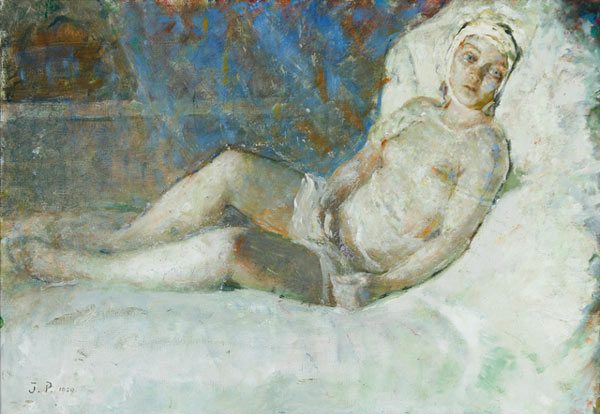
Paulsen continued to paint and exhibit throughout his life, remaining active in the Danish art scene until his death on February 17, 1940. His later works, such as “Old Fisherman” (1930) and “Winter Landscape” (1935), reflect a continued refinement of his technique and a deepening of his thematic concerns.
Paulsen’s legacy is one of dedication to the craft of painting and a profound sensitivity to the human condition. His work is characterized by a careful balance of technical precision and emotional depth, making him a significant figure in Danish art history.
Paulsen’s Artistic Techniques and Themes
A deeper look into Paulsen’s techniques reveals his mastery of light and shadow. He often used a limited color palette, relying on subtle variations of tone to create depth and atmosphere. This approach can be seen in works like “The Philosopher” (1910), where the interplay of light and dark adds to the contemplative mood of the piece.
Paulsen was also fascinated by the human face and form. His portraits go beyond mere likeness to explore the character and inner life of his subjects. In “Portrait of a Young Woman” (1915), for example, the delicate rendering of the woman’s features and the soft, diffused light create a sense of quiet introspection.
Critical Reception and Exhibitions
Throughout his career, Paulsen’s work was exhibited widely, both in Denmark and internationally. He participated in major exhibitions such as the World Exhibition in Paris (1889) and the Venice Biennale (1909), where his paintings were admired for their technical excellence and emotional resonance.
Critics often praised Paulsen’s ability to convey the subtleties of human emotion and his meticulous attention to detail. His work was seen as a continuation of the Danish Golden Age tradition, while also incorporating modern influences and ideas. This blend of old and new made Paulsen a unique and important figure in the art world.
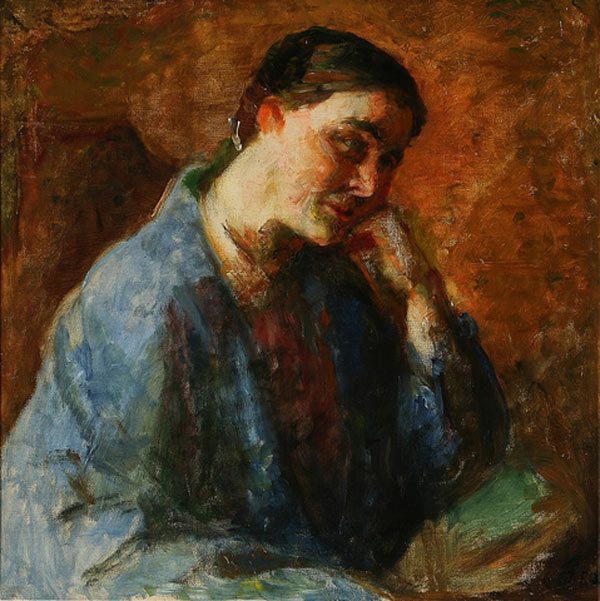
Despite his success, Paulsen remained a humble and dedicated artist. He was known for his quiet demeanor and his commitment to his craft. His contemporaries often remarked on his meticulous nature and his ability to capture the essence of his subjects with a few deft strokes of the brush.
Paulsen’s personal life was marked by a deep connection to his family and his homeland. He often drew inspiration from the Danish landscape and the people around him, infusing his work with a sense of place and belonging. This connection to his roots is evident in works like “Landscape with Cows” (1900), where the serene Danish countryside is depicted with loving attention to detail.
Paulsen in the Context of Danish Art
Julius Paulsen’s work occupies a unique place in Danish art history. He is often seen as a bridge between the Danish Golden Age and the modernist movements of the early 20th century. His ability to blend naturalism with symbolism, and his focus on the psychological aspects of his subjects, set him apart from his contemporaries.
Paulsen’s influence can be seen in the work of later Danish artists, who were inspired by his technical skill and his emotional depth. His legacy is also preserved in the many portraits he painted, which offer a window into the lives and characters of the people of his time.
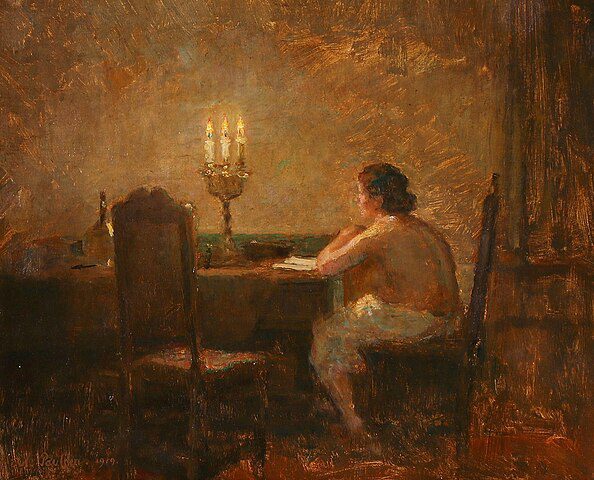
Julius Paulsen’s life and work are a testament to the power of art to capture the complexities of human experience. From his early days in Odense to his later years as a respected teacher and artist, Paulsen remained dedicated to exploring the interplay of light and shadow, both in the physical world and in the realm of human emotion. His paintings continue to be celebrated for their technical mastery and their profound sensitivity, securing his place as one of Denmark’s greatest artists.
In the galleries and museums where his work is displayed, viewers can still feel the presence of Paulsen’s keen eye and gentle spirit. His portraits, landscapes, and genre scenes invite us to look beyond the surface and to see the world through his eyes – a world of subtle beauty and deep emotion. As we reflect on his legacy, we are reminded of the enduring power of art to connect us with the past and to illuminate the human condition.




